Potential Potholes in Economic Recovery, Gold Patience Required Ahead of Seasonally Strong Period
Stock-Markets / Gold & Silver 2009 Aug 24, 2009 - 01:12 AM GMT Economy - Bank of Israel Governor Stanley Fischer had some interesting comments at the annual symposium sponsored by the Federal Reserve Bank of Kansas City in Jackson Hole, Wyoming, that addressed some of the potential potholes on the road to recovery:
Economy - Bank of Israel Governor Stanley Fischer had some interesting comments at the annual symposium sponsored by the Federal Reserve Bank of Kansas City in Jackson Hole, Wyoming, that addressed some of the potential potholes on the road to recovery:
"Growth does appear to be beginning to resume. Much remains to be done, not least in bringing banking systems back to health, and there are good - though not conclusive - reasons to fear a sub-standard recovery."
The above remarks are in keeping with the positive yet cautionary stance taken by Trichet and Bernanke that we saw earlier in the report. It would seem that the best position is to be cautiously optimistic. Fischer then went on to say:
"We seem to be taking it for granted that we should go back to the structure of the financial system as it was on the eve of the crisis. But we need to be thinking more broadly, including the possibility that some radical restructuring is needed."
This I agree with, although most likely a bit more intensely than Mr. Fischer. It is the structure of the world's financial system that got us into the mess we're in: namely, the paper fiat debt-based monetary system - a structure as unsound as they come.
Mr. Fischer is correct: a radical restructuring is needed. As a matter of fact, the present system of paper fiat debt-money cannot be fixed - it must be replaced with an honest system of gold and silver money, as mandated by the U.S. Constitution.
A monetary system of gold and silver is not based on debt. This is why the Founding Fathers approved of it in the Constitution. Anything less will simply be a band-aid approach destined to fail, just as the present system was destined, and perhaps preordained to fail.
The Central Bank Governor from Israel continued on to say:
"We need also to remember that every financial crisis is different, each in its own way, and that in seeking to prevent future crisis we need to seek out and deal not only with the factors that caused the present crisis, but also with those that could cause the crises of the future. We may be relaxing too soon, thinking the crisis is past when that is far from sure."
While I partially agree with what Mr. Fischer states here, I don't think he fully grasps the complexity or root cause of what he refers to as the financial crisis. He is correct to caution against factors that not only caused the present situation, but could also cause further crises in the future.
It is true that financial crises differ one from another, however, the important issue is how and why they differ. While secondary or indirect causes may differ from one crisis to the next, the root cause of all financial crises stems from the same root that beget them: the system of paper fiat debt-money that is the monetary foundation of all financial and economic systems built thereon. The metaphor may be trite - nonetheless true: if the foundation of a structure is unsound, so too is the structure itself. It is doomed to fail. It is not a question of if - but when.
The following charts show the most important sectors of the economy that need to improve if any sustainable recovery is to occur. The problem, however, is the money. Excessive money creation is what got us into this mess. Throwing more fuel on the fire in the form of additional credit is not going to fix anything. Such a policy defies rational thought.
Money cannot be a debt instrument (Federal Reserve note) or a promise to pay. It must be payment - not a promise thereof. The two are as different as day and night. This is why the Founding Fathers wrote a disability in the Constitution that forbids bills of credit (promissory notes) from circulating as legal tender between the States; and only approves gold and silver coin to be legal tender.
But I digress - back to the economy, and the sectors that must improve, if a sustainable recovery is to occur. Capacity utilization indicates how busy our factories are - and how much we are producing. If our factories are not producing, then fewer workers are needed, and consequently, more people are out of work. The chart below tells a story of weakness - not strength.
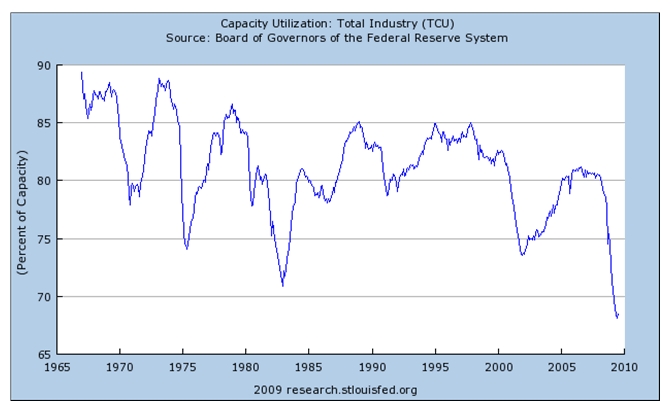
Another critical issue is income. Obviously, the more income people have, the better off they will be - well, sort of. This is one of those sticky points most pundits do not agree on, or do not want to admit is true - or both.
The amount of money (quantity) is not the most important factor when determining well being or wealth. It is the purchasing power of money (quality) that is most crucial. The more goods that a unit of money can procure, the more value it has.
This is the exact problem with paper fiat debt-money. It is continually created in excessive amounts (quantities) that thereby reduce its purchasing power (quality). This is what causes price inflation.
It is not so much that the prices of things rise on their own, as it is that the number of units (quantity) of money needed to buy them goes up, because the purchasing power (quality) of money decreases, due to its over issuance, thereby requiring more units to buy the same amount of goods.
Since the Fed was created in 1913 the U.S. dollar (Federal Reserve Promissory Note) has lost 96% of its purchasing power. Even the Federal Reserve has the audacity to admit such malfeasance.
The Federal Reserve is a complete failure and should be abolished. For full details see the book: Honest Money. Evidence the excess money/credit/debt growth below.
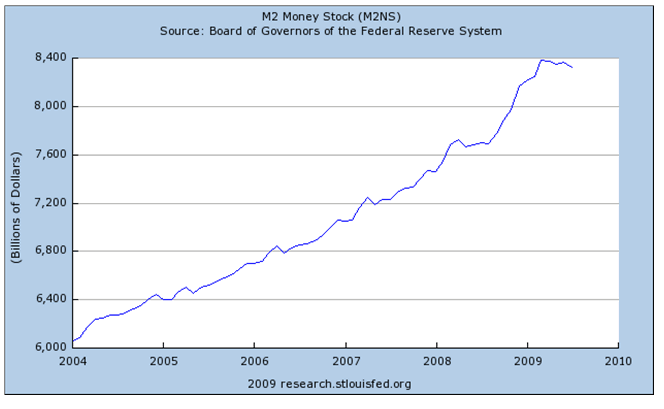

Former Nobel Prize-winning economist Joseph Stiglitz gave a speech at a conference in Bangkok last week. One of his statements addressed the exact issue of the creation of credit and the Fed's ballooning balance sheet.
"As the balance sheet of the Fed has blown up, as the deficit of the U.S. and the debt has increased, people have asked the obvious question: will there be inflation in the future? Right now we're facing deflation, but sometime in the future, there will be consequences."
Evidence the chart below, which shows the Fed's balance sheet skyrocketing higher - more than doubling in half a year. It has since cooled off, but is still in a clear uptrend, with a series (4) of higher lows in place.
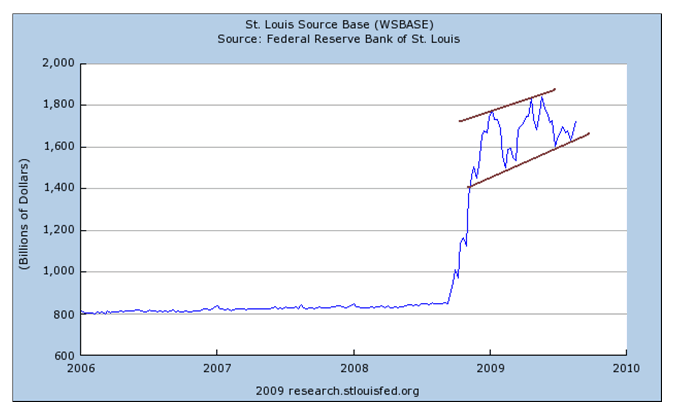
Stiglitz's remarks center on a new world reserve currency and an overhaul of the existing financial system, which, depending on the structures implemented, could be a good thing - or a recipe for disaster.
Any continuance of a paper fiat monetary system is doomed to fail, regardless of which currency, or basket of currencies, is used. If they are promissory notes, all they can accomplish is wealth transference from the many to the few; which is the exact reason the elite banking families created central banks to begin with. SDR's are no different and never will be.
"There is a need for a global reserve system. The current reserve system is in the process of fraying. The dollar is not a good store of value. Right now, the dollar is yielding almost no return and yet anybody looking at the dollar has to say there's a high degree of risk."
Notice Stiglitz's reference to "store of value". This is the exact point: only gold and silver have endured for millenniums as a sound store of value. Stiglitz also warns that the money being printed (liquidity) is ultimately going to be spent, but that it might not necessarily be spent in the United States. Stiglitz went on to caution that Asian economies may have to "protect against an American-led asset bubble."
As has been shown above, many different opinions exist on the state of the world economy, and its financial and monetary systems. Now, for some charts and remarks not often made.
Total U.S. private credit market debt, as a percentage of GDP, reached 250% in 1929. This level was not exceeded until 1999, when it hit 350% during the boom that has now gone bust. Without the excessive debt expansion there would not have been a boom; and subsequently - no bust.
The best way to fight deflation is to stop the inflation that comes first. The same is true for hyperinflation. Sound monetary policy is just that - sound. Gold and silver endure for ages - paper does not.
Now, let's look at total U.S. debt versus national income. The numbers are frightening, especially for those to come: our children and their children. Such imbalances cannot be sustained in a free society. If these excesses are allowed to continue unabated, a society built on debt-servitude will become the future of our children.
This is not the American dream by any stretch of the imagination. It is a nightmare of the highest order and must be stopped. The following chart is from the Grandfather Economic Report by Michael Hodges, whose work is unparalleled in my opinion. Note the figures are only through 2008. 2009 is not included.
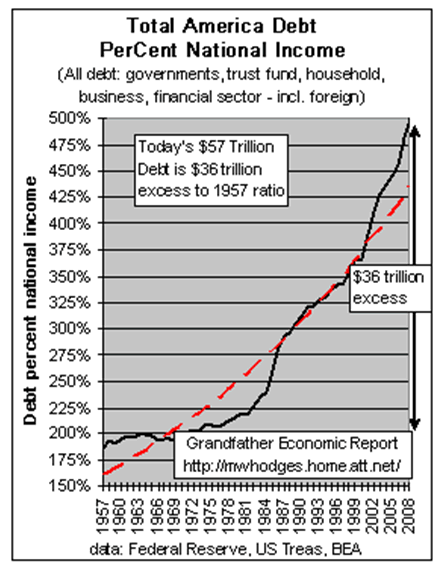
That is not a pretty picture, but it is an honest chart; and attention is advised. To ignore the implications is to ignore the future of our children and their children to come. It is the shadow of a recurring nightmare, until it is no more. Only an honest monetary system can put it to rest - one of gold and silver coin.
The global financial crisis, which began with the collapse of the U.S. subprime-lending market in 2007, has led to almost $4 trillion of write-offs and credit losses at banks and other financial institutions around the world, as evidenced by the chart below, from the International Monetary Fund (IMF).
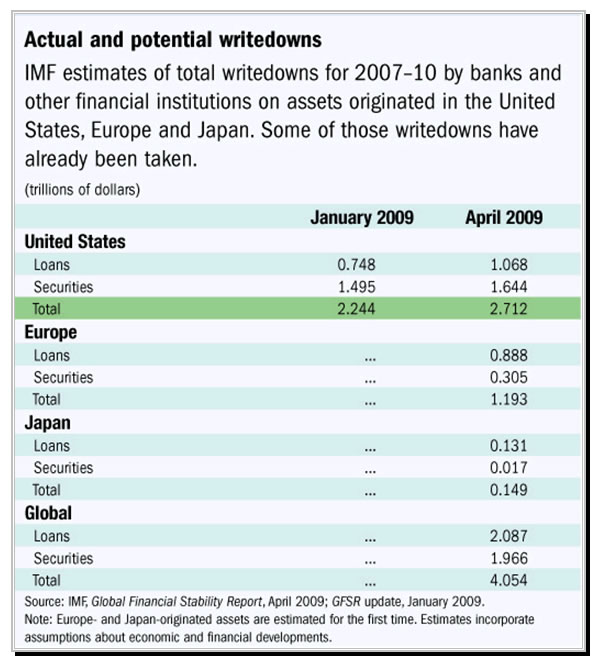
However, this is not the complete story, as it only represents losses to financial institutions. What about the people? How much wealth have they lost in their homes, stock portfolios, and other financial assets?
Such a number is difficult to calculate, although various estimates have been given by different "authorities" - running from $25 trillion to $50 trillion dollars. This sum is staggering and equals the yearly GDP of the entire world. In forthcoming papers I will attempt to quantify these numbers, for the purposes here intended, I will acquiesce and use the lowest figure: $25 trillion.
What is rarely mentioned when discussing the financial crisis is whether anyone profited from it? For example: interest rates fell dramatically for many years. Since bond prices move in the opposite direction from interest rates, huge profits must have been made by someone, just as they were during the Great Depression.
Further to the above is the listing of the Bank for International Settlements derivative positions, as evidenced by the chart below. Note that collectively, profits on such positions are nearing $20 trillion dollars. Perhaps it's true that wealth doesn't disappear, but simply changes hands.
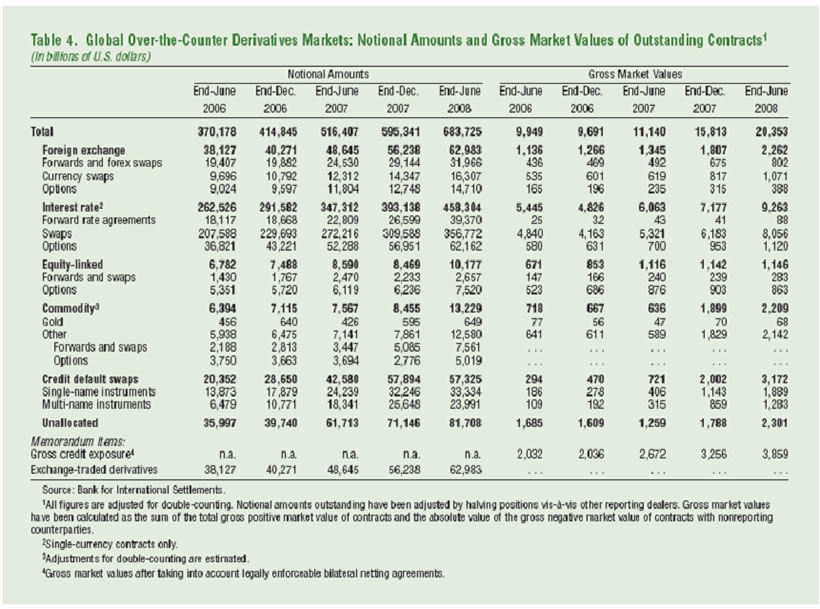
The important numbers are the totals taken from the first row of the top chart: 9 trillion in 2006 and $20 trillion in 2008 for an $11 trillion increase.
On the second chart note the numbers in the seventh row from the top: $69 trillion in 2006 to 77 trillion in 2008, for an $8 trillion dollar gain. Note that both of these charts only go to the year 2008.
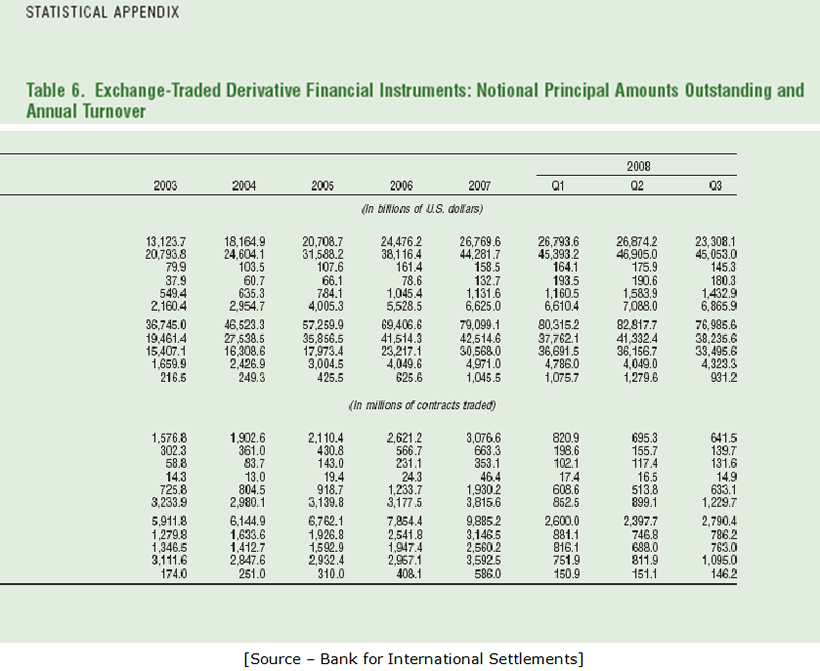
[Source - Bank for International Settlements]
Gold
Gold had a decent week, gaining $5.00 or +0.53% to close at $953.70. I have been getting a lot of emails and questions on my website about gold's performance, or lack thereof. There are many who are concerned that the sovereign of sovereigns is acting weak, when it should be acting strong.
First, gold is presently at $953 or $80 dollars from its all-time high ($1033). This means that gold is presently 7.7% away from its record high. I don't know of any other asset that can come close to making that claim.
Many other commodities have rallied much more than gold has this year, but they also fell much further from their highs, and have not even gained half of their losses back. Gold has done its job - it has performed well, as a store of value during hard times.
All during its bull market, gold has taken long periods of consolidation before embarking upon its next move up. Some of these moves took 12-16 months. Presently, gold has been consolidating for about 6 months.
Also, seasonally, the summer is the weakest time for gold, with rallies usually coming in the fall to winter time period. Patience is required.
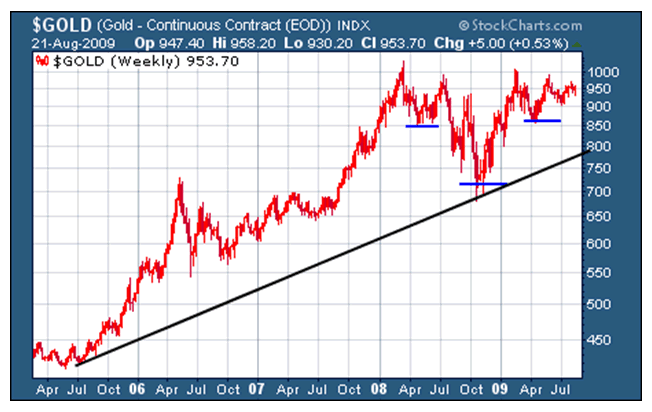
Next up is a daily chart of gold that has comparisons to copper and oil at the bottom of the chart. Notice how both copper and oil have outperformed gold on a percentage basis since March. This suggests that gold is not trading so much as a commodity, as it is as a currency.
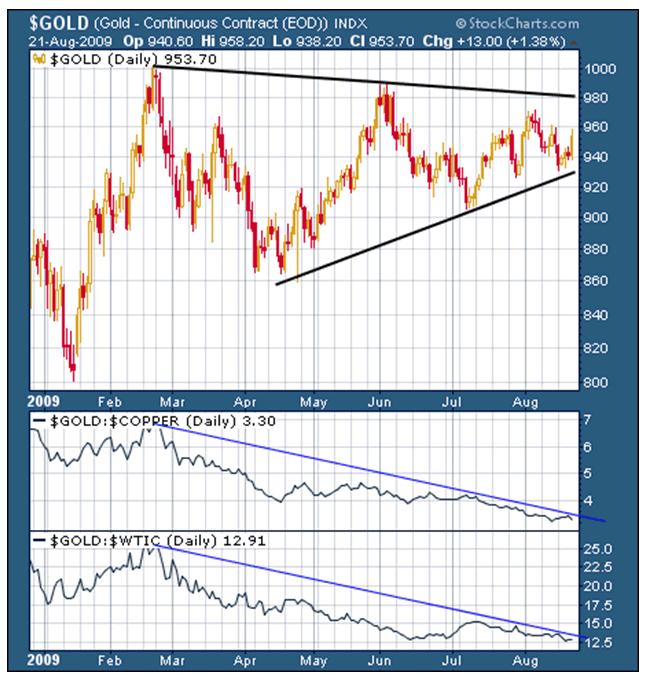
Note the series of higher lows. Now, what are needed are higher highs: first is the August high, followed by the June high, and then the March high, and finally on to new all-time highs.
The above excerpt is a small sampling from the latest full-length version of this week's market wrap report (38 pgs), available only at the Honest Money Gold & Silver Report website.
All major markets are covered with the emphasis on the precious metals. The markets are at important inflection points and there will be some big winners and losers just ahead. A free trial subscription is available by submitting a request to: dvg6@comcast.net.
Stop by and check out the myriad forms of information available, not only on investing, but on the history of gold and silver money as mandated by the U.S. Constitution, which is the answer to the present financial crisis, and one's own personal financial protection.
Good luck. Good trading. Good health, and that’s a wrap.

Come visit our website: Honest Money Gold & Silver Report
New Audio-Book Now Available - Honest Money
Douglas V. Gnazzo
Honest Money Gold & Silver Report
About the author: Douglas V. Gnazzo writes for numerous websites and his work appears both here and abroad. Mr. Gnazzo is a listed scholar for the Foundation for the Advancement of Monetary Education (FAME).
Disclaimer: The contents of this article represent the opinions of Douglas V. Gnazzo. Nothing contained herein is intended as investment advice or recommendations for specific investment decisions, and you should not rely on it as such. Douglas V. Gnazzo is not a registered investment advisor. Information and analysis above are derived from sources and using methods believed to be reliable, but Douglas. V. Gnazzo cannot accept responsibility for any trading losses you may incur as a result of your reliance on this analysis and will not be held liable for the consequence of reliance upon any opinion or statement contained herein or any omission. Individuals should consult with their broker and personal financial advisors before engaging in any trading activities. Do your own due diligence regarding personal investment decisions. This article may contain information that is confidential and/or protected by law. The purpose of this article is intended to be used as an educational discussion of the issues involved. Douglas V. Gnazzo is not a lawyer or a legal scholar. Information and analysis derived from the quoted sources are believed to be reliable and are offered in good faith. Only a highly trained and certified and registered legal professional should be regarded as an authority on the issues involved; and all those seeking such an authoritative opinion should do their own due diligence and seek out the advice of a legal professional. Lastly Douglas V. Gnazzo believes that The United States of America is the greatest country on Earth, but that it can yet become greater. This article is written to help facilitate that greater becoming. God Bless America.

Douglas V. Gnazzo © 2009 All Rights Reserved
© 2005-2022 http://www.MarketOracle.co.uk - The Market Oracle is a FREE Daily Financial Markets Analysis & Forecasting online publication.



